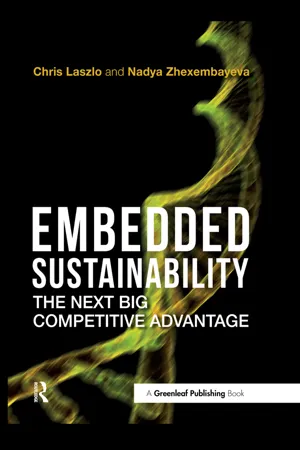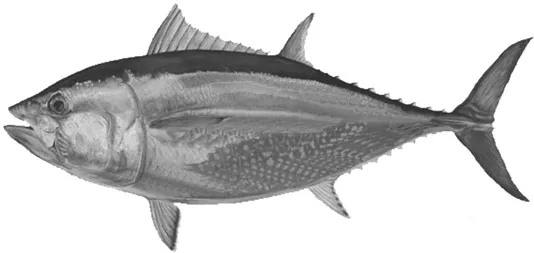Looking deeper into the economic, social, health, and ecological pressures that fall under the sustainability umbrella, one finds three distinct but interconnected trends: declining resources, radical transparency, and increasing expectations. Together, these trends are becoming a major market force that is redefining the way companies compete. It has now reached a critical point, changing the rules for profit and growth in almost every sector of the economy.
Here are the pieces of the new business puzzle.
Declining resources
Takeharu Jinguji has been watching a steady decline of bluefin tuna in Japanese waters for years. His longline fishing boat competes with net-fishing folk who also catch smaller species, and for Takeharu, the issue of tuna and its entire food chain is vital to his livelihood: “… the total number of fish has been decreasing a lot. So the biggest problem for me is that my income has been reduced.”12 His observations reflect a stark new reality: bluefin tuna has been heavily overfished in all but the Antarctic waters, with stocks at less than 10 per cent of what they once were.13 Are you at a sushi restaurant looking for maguro or toro, the highest grade of tuna? You may be out of luck… or out of money. Today, bluefin tuna has become so rare that a single, healthy-sized adult recently fetched $396,000 in Tokyo’s largest fish market.14 So, staring at a picture of a fully grown specimen might soon become our only option …
When we share the story of Takeharu Jinguji at conferences and executive education seminars, we are often met with disbelief. One manager recently told us that such exaggerations and myths weaken the cause of sustainability. “I simply can’t believe that the population of bluefin tuna has declined by 90 per cent” was his response.
And yet bluefin tuna is only the tip of the iceberg. According to a Stanford University study, overfishing could take all seafood off the menu by 2048. “Unless we fundamentally change the way we manage all the oceans species together, as working ecosystems, then this [20th] century is the last century of wild seafood,” notes marine biologist Stephen Palumbi of Stanford University.15
Companies across industries and continents are being increasingly affected by the rapid decline of natural resources. Attention to this topic is not new. Long before The Natural Step – a sustainability framework developed in the 1980s that put declining resources at the center of the business-in-society debate16 – the issue of resource scarcity had the attention of scholars and practitioners alike. Indeed, the notion of unbounded growth in a finite world is nearly as old as economics itself,17 tracing back to Plato’s subordination of family size to the common good18 and in later times to Thomas Malthus’s warnings about the dangers of unchecked population growth.19
More recently, in-depth explorations such as the 1963 Scarcity and Growth by Harold Barnett and Chandler Morse20 concluded that resource scarcity was virtually nonexistent, with those conclusions in turn being strongly questioned by the 1972 Club of Rome’s Limits to Growth.21 Since then, the two opposing groups have been endlessly debating the (in)exhaustibility of resources. First, there are the proponents of unlimited growth, sometimes called “cornucopians,” in reference to cornucopia, or the horn of plenty, a symbol of abundance dating from the ancient Greeks. Most adherents to this philosophy believe in the miracles of neo-classical economics and technological progress. The cornucopians contrast with the tribe of Neo-Malthusians, who believe that growth limits are imposed by the environment. The dispute between the two factions continues to this day.22
While the debate is not new, recent years have seen renewed concerns about the rapid decline of natural resources, voiced by international bodies such as WWF. Its Living Planet Report warns that “the possibility of financial recession pales in comparison to the looming ecological credit crunch”.23 While the level of decline in certain resources such as oil remains hotly debated,24 other data is less contested.25 Even a brief scan across recent studies suggests a strong and clear trend at the level of the planet itself:
- Clean water supply is seeing significant mismatches with demand,26 especially in Asia, Africa, and Europe.27 An estimated 1.1 billion people lack access to safe drinking water, while 2.6 billion people lack adequate sanitation, and 1.8 million people die every year from diarrheal diseases, including 90 per cent of children under five who are struck by water-borne disease28
- Food security is emerging as a central issue of the new millennium, with food prices29 and price volatility30 reflecting the uncertain state of the world’s food supply. But even if enough food is produced to feed everyone, it appears that the nutritional value of crops has been on the decline: a recent study shows an average decline of 6 per cent in protein, 16 per cent in calcium, 9 per cent in phosphorus, 15 per cent in iron, 38 per cent in riboflavin, and 20 per cent in vitamin C from 1950 to 1999 across 43 garden variety crops31
- Energy security is equally troublesome, with new energy demands largely driven by growth in the BRIC countries (Brazil, Russia, India, and China). Price volatility and geopolitical dependence on a few supplier countries located mostly in the Middle East are seen as growing risk factors.32 By 2030, the world’s primary energy demand is expected to reach a breathtaking 40 per cent higher than 200733
- Biodiversity has seen a rapid decline. The Millennium Ecosystem Assessment34 reports that, over the past few hundred years, humans have increased species extinction by as much as 1,000 times the rates typical over Earth’s history; the bluefin tuna is one of many species bordering on extinction35
We can continue this list indefinitely at a risk of losing you to frustration or apathy, the way much of the environmental movement has done before us. We can also add to the list the many “social” resources that add market pressure, whether it is physical security, health, education, or social equity. Our purpose, however, is different. We are committed to sharing an exciting but largely invisible story of a shift in the conduct of business. In the new narrative, the gloom and doom of declining resources is also the foundation for opportunity, an emerging paradigm of business that can be more sustainable and more profitable.
The paradigm shift is embodied in the story of Terra Cycle, a company known for producing the world’s first product made from 100 per cent post-consumer garbage. It is best known for its colorfully named “Worm Poop” – an organic fertilizer created by feeding organic waste to millions of worms that consume and process the waste material, which is then packaged into recycled soda bottles. Nearly two hundred other products have been developed since the first introduction of Worm Poop, and the company is now operational in five countries.
Beyond the efforts of niche start-ups, the shadow of resource decline is finding its way into the stories of well-established mainstream companies, such as Shaw, one of the world’s largest flooring manufacturers, now owned by Warren Buffett’s Berkshire Hathaway. At Shaw’s Evergreen closed-loop operation, old pieces of carpet are ground and processed into their original components, with nylon and other precious raw materials recycled indefinitely into new carpet, without any loss in aesthetic or performance properties.
What Terra Cycle and Shaw illustrate is the resource crunch transformed into a new business opportunity. As it quietly marches through industries and continents, a wave of new thinking is entering the mind of business.
Declining resources may have been the headline news of 1798, the year of Thomas Malthus’s essay on population. What is so important about this trend now? Surprisingly, the difference is rather striking: never before have we seen the speed, extent, and magnitude of resource loss that we observe now. Whether it is soil, water, nutrition, a stable climate, or social equity as measured by the rich–poor gap, the list of declining resources in question is relevant for nearly the entire global economy, with no company left unaffected. And that, in turn, creates a fundamental change in how companies compete to create enduring value.
Just consider this: for as long as we can remember, three primary factors – the three Cs – have been guiding business strategy: customers, capital, and competition. If meeting customer needs represented the grand prize, with access to capital as the indispensable lubricant and competitive positioning providing the unique route to victory, now there is an entirely new factor to consider: security of the value chain. A company might have the best product for the right customer at the right price, but a natural resource crunch upstream in the value chain could wipe out all profits, if not the entire industry. Think tuna: if we put ourselves in the shoes of the fishermen, it is not only fish lovers, wholesale markets, or fellow fishermen that we need to worry about. Now, it is the plankton and the small catch hidden in the tuna’s food chain that will determine whether we sink or swim.
And that is only the beginning.
Radical transparency
While the resource crunch is reaching historic proportions, its impact is being amplified by a second big trend that itself is reshaping the business environment – radical transparency. Fueled by the unprecedented growth of the civil sector and enabled by rapid developments in the field of information technology, transparency has become the dynamic, immediate, and substantive force of modern corporate life.
Now, we might be using some strong language here, so let us pause for a second and examine a few facts. What is happening, exactly, to bring about radical transparency and how is it relevant for business?
First: the power of numbers
Among the many important developments that are making business increasingly transparent, the rise of civil society must be considered primus inter pares. From humble beginnings in Cicero’s societas civilis to the global power of influence in the present day, the number of voluntary social and nonprofit organizations dedicated to societal and environmental concerns has surpassed the 1 million mark.36 For the sake of simplicity, let us imagine that each of these organizations unites the efforts of only ten people – whether volunteers or employees. That means that at this very moment, at least 10 million full-time activists (!) are putting sustainability at the center of their lives – many pursuing visions of social equity or healthy ecology with as much strategy, efficiency, rigor, and innovativeness as any well-run business. It is precisely this collective strength that leads observers such as Paul Hawken to refer to this wave of civic action as “the largest movement on Earth.” An author of several best-selling books, including his seminal work The Ecology of Commerce, Hawken explores the growing influence of the nonprofit sector on business and society in his 2007 Blessed Unrest: How the Largest Movement in the World Came into Being, and Why No One Saw it Coming37 – a great resource and colorful read for those grappling with the idea. But whether it is through the pages of passionate visionaries or through daily encounters with influential NGOs, one thing becomes crystal clear: throughout the world, millions of minds are now dedicated to measuring, recording, making very visible, and ultimately improving the social and environmental well-being of society at l...

